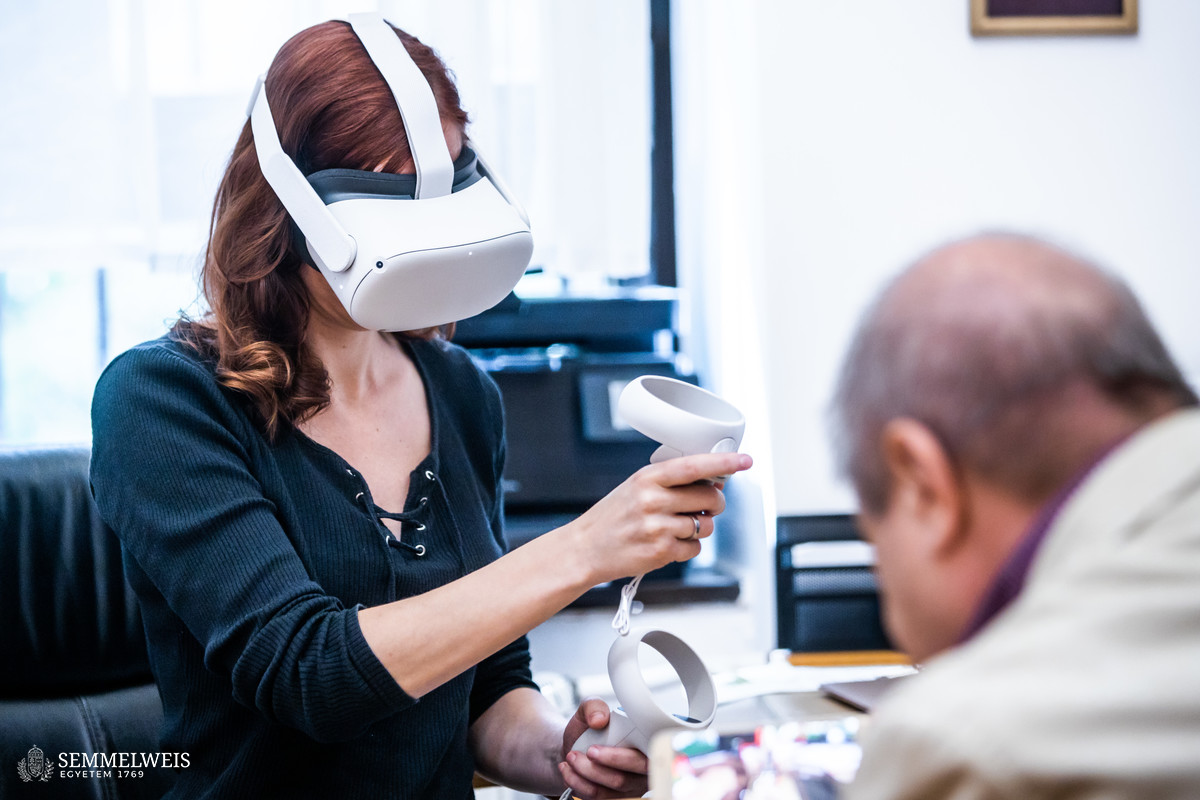With the VR-ToMIS method (Virtual-Reality based Theory of Mind Intervention in Schizophrenia), the researchers hope to improve the patients’ so-called mentalisation (Theory of Mind) skills, which, according to the literature, shows the closest association with prosperity in life.
 “Theory of Mind is our ability to interpret the feelings, thoughts, and desires of others. Schizophrenic patients tend to decode these messages incorrectly. They often struggle to understand irony and metaphors or misunderstand certain gestures. Our method aims to improve these skills,” explains Dr. Lajos Simon, head of the Virtual Reality and Emotion research group at Semmelweis University.
“Theory of Mind is our ability to interpret the feelings, thoughts, and desires of others. Schizophrenic patients tend to decode these messages incorrectly. They often struggle to understand irony and metaphors or misunderstand certain gestures. Our method aims to improve these skills,” explains Dr. Lajos Simon, head of the Virtual Reality and Emotion research group at Semmelweis University.
Although there have been previous attempts to treat certain aspects of schizophrenia with VR therapy, this is the first to help patients to recognise emotions and better understand the intentions of others.
VR-ToMIS, developed using the British company vTime software, consists of one introductory and eight 50-minute-long intervention sessions. Patients wear VR glasses during the meetings, which “place them” in everyday situations. At the same time, they interact with an avatar controlled by a therapist. For example, the patient walks on the beach when the avatar asks them to help to find a missing dog.
“If the patient refuses to help, the avatar’s response can be an ironic ‘What a helpful person!’. Schizophrenic patients often take this literally and fail to perceive the double meaning in such reactions, which makes their lives extremely difficult,” adds Dr. Lajos Simon.
 The programme can also simulate a blind date, moving in with a new roommate, conversing in a cafe, or getting to know a new colleague.
The programme can also simulate a blind date, moving in with a new roommate, conversing in a cafe, or getting to know a new colleague.
“Suspicion is a dominant thought in schizophrenic conditions, and with our VR therapy, the patients can learn how to recognise that people usually don’t have ulterior motives,” says Dr. Edit Vass, an assistant lecturer at the Department of Psychiatry and Psychotherapy and co-developer of the novel VR therapy.
The researchers built repeatedly and carefully tested dialogues into the software so they could use the most common and effective forms of different situations, which also combine elements of irony, metaphor or humour.
During the sessions, the simulation task is followed by an interactive exercise using another novel virtual device, the “temporal disc controller”. IT specialist Barnabás Takács developed the device where the patients see a 3D face on a screen. With a mouse, they can display the emotions attributed to the avatar in the simulation task. This virtual task can help depict the inner states that people with schizophrenia often find difficult to express verbally.
This step of the session is followed by an analytical discussion. Then, the entire process is repeated throughout the session so the patients can memorise the cognitive processes and the experienced emotional states.
Schizophrenia is considered one of the 20 most common disabilities, and according to the World Health Organization, approximately 24 million people may be affected worldwide,
explains Dr. Vass.
The disease is characterised by repeated psychotic episodes when patients disconnect from reality suffering from hallucinations and delusions. The patient’s train of thought often becomes untraceable, and their speech disorganised – they get more withdrawn and are challenging to communicate with.
 “In 75% of cases, schizophrenia is also associated with functional impairment: the ability to lead an independent life decreases and the patient’s work and social life falls apart, despite the traditional and medical therapies. This affects their relatives, friends and colleagues, so the social burden of the disease is extremely significant,” says Dr. Edit Vass.
“In 75% of cases, schizophrenia is also associated with functional impairment: the ability to lead an independent life decreases and the patient’s work and social life falls apart, despite the traditional and medical therapies. This affects their relatives, friends and colleagues, so the social burden of the disease is extremely significant,” says Dr. Edit Vass.
The development of VR-ToMIS began in 2016 and testing finished in 2022 involving 43 patients (22 active, 21 control). The Hungarian researchers published the most significant results in the journal Comprehensive Psychiatry.
On completion of the VR-ToMIS therapy, they observed a significant improvement in the cognitive (coherent thinking, social cognitive deficit, Theory of Mind) and negative (emotional blunt, decreasing facial expressions, apathy) symptoms of the participants in the VR-ToMIS group.
The intervention also improved the patients’ simpler and more complicated mentalisation skills compared to the traditional therapies, which generally only proved to be effective in more straightforward tasks.
Nearly 80% of the relatives interviewed for the study perceived an improvement in the patients’ communication skills immediately after the training. Three months later, progress was also measurable in the patients’ quality of life, indicating that they could successfully integrate the learned skills into their daily lives.
According to previous research, genetic and environmental factors may play a role in the development of schizophrenia. The onset can be as a young adult, but also in the thirties and forties.
93.3% of patients felt that using the VR device was safe, and 80% found it pleasant to communicate with the avatar, which, according to the researchers, could be the main advantage of VR therapies: in sensitive and sometimes frustrating situations, the patients can pause the simulation, and direct their emotions towards an artificially created and not a real person.
“Compliance is the biggest challenge in the treatment of schizophrenia patients. One of the greatest successes of our method was that none of them dropped out during the test period, and their willingness to cooperate remained throughout,” Dr. Vass sums up the results.
A Hungarian industrial trademark protects the VR-ToMIS. The next step is to develop a course to train other professionals to use the method. Within two years, Semmelweis University can obtain the international trademark.
Fotó: Balint Barta – Semmelweis University; some images are the property of vTime Limited



